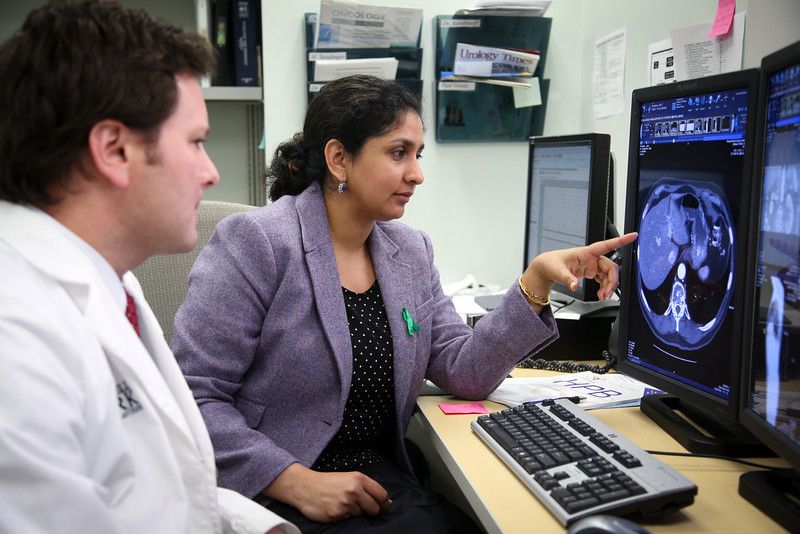What is a Neuroendocrine Tumor?
A neuroendocrine tumor is a tumor that forms from specialized cells that release hormones into the blood in response to a signal from the nervous system. Neuroendocrine tumors may make higher-than-normal amounts of hormones, which can cause many different symptoms. These tumors may be benign (not cancer) or malignant (cancer).
Some examples of neuroendocrine tumors are carcinoid tumors arising anywhere in the body, islet cell tumors, medullary thyroid cancer, pheochromocytoma, neuroendocrine carcinoma of the skin (Merkel cell cancer), small cell lung cancer, large cell neuroendocrine carcinoma, atypical lung cancer and typical lung cancer.
Diagnosis and treatment of neuroendocrine tumors depend on the type of tumor, location, aggressiveness, and extent of metastases (spread to other organs).
Types of Neuroendocrine Tumors
Carcinoid Tumor
These tumors more often develop in the GI tract in organs such as the stomach, small intestine, pancreas, liver, colon, appendix, rectum, or in the lungs. However, they can also develop in other parts of the body such as liver, ovaries, testicles and other organs.
Carcinoid tumors are formed by the cells that produce hormone-like substances, but in some instances, the level of these substances produced might not be high enough to cause any symptoms. These type of carcinoid tumors can continue to grow for years without producing any obvious symptoms.
Every year, about 12,000 adults are diagnosed with a carcinoid tumor in the United States. The 5-year survival rate for patients diagnosed with carcinoid tumor depends on the type, location and extent of spread of the tumor. The 5-year survival rate ranges from vary depending on the stage and treatment.
Pheochromocytoma
This type of tumor is developed from the cells located in the middle of the adrenals that produce stress hormones; i.e., the hormones produced during the time our body is in stress. Some of the hormones produced by this type of tumor include adrenaline and noradrenaline. It is a benign tumor but can lead to life-threatening circumstances as a result of severe rise in blood pressure and heart rate caused by excess levels of hormones.
Islet Cell Tumor
This type of tumor develops in the hormones secreting cells of the pancreas, known as Islets of Langerhans. They can be benign or malignant, as well as functioning (produce hormones) or non-functioning (do not produce hormones). Most of these tumors are nonfunctioning, hence leading to an advanced diagnosis due to a lack of any symptoms.
There are different types of islet cell tumors that derive their nomenclature from the type of hormones produced by them. These include:
- Gastrinoma: Produces excess levels of gastrin
- Insulinoma: Produces excess levels of insulin
- Glucagonoma: Produces excess level of glucagonoma
- VIPoma: Produces excess level of vasoactive intestinal peptide (VIP)
- Somatostatinoma: Produces excess level of somatostatin
Each year, about 1000 people are diagnosed with islet cell tumors in the United States. They account for 3-5 percent of all pancreatic cancers. The 5-year survival rate for people diagnosed with islet cell tumor is about 42 percent.
Merkel Cell Cancer
This is a rare, rapidly growing and aggressive type of cancer that develops hormone-producing cells that are situated at the base of the outermost layer of the skin (epidermis). The risk of this type of cancer increases with age.
Neuroendocrine Carcinoma
This category of neuroendocrine tumors includes the ones that cannot be categorized in other specific neuroendocrine tumors. They can develop in various organs of the body including the brain, GI tract and lungs.
Who is at Risk?
Knowledge about the risk factors can help make lifestyle changes as well as informed decisions about personal healthcare following consultation with your healthcare provider(s).
The following are the risk factors associated with higher risk of developing neuroendocrine tumor:
- Age: The incidence of pheochromocytoma is high between the ages of 40-60 years. The risk of developing Merkel cell cancer increases after the age of 70 years.
- Race/Ethnicity: The diagnosis of NETs is more common in Caucasian populations, but there have been cases of NETs diagnosed among people of African American and Asian descent.
- Gender: There is a higher risk of developing pheochromocytoma and Merkel cell cancer in men than women.
- Family History/Heredity: Some studies have shown that a history of any cancer in a first-degree relative increases the risk of developing NETs.
- Multiple Endocrine Neoplasia type 1 (MEN1): increases the risk of developing NETs in the parathyroid gland, pituitary, pancreas, as well as in the GI tract and lungs.
- Multiple Endocrine Neoplasia type 2 (MEN2): is usually associated with medullary thyroid carcinoma, but can also lead to phaeochromocytoma and parathyroid adenoma.
- Von Hippel-Lindau Syndrome: is associated with tumors and cysts in different parts of the body that includes pheochromocytoma and NETs of the pancreas.
- Neurofibromatosis type 1: is usually associated with non-cancerous tumors of nerves and skin. It also increases the risk of developing NETs of the GI tract, pancreatic NETs, pheochromocytoma and gastrointestinal stromal tumors (GISTs).
- Tuberous Sclerosis: also increases the risk of developing NETs.
- Immune System Suppression: The risk of developing NETs is higher in individuals with Human Immunodeficiency Virus (HIV) infection, Acquired Immune Deficiency Syndrome (AIDS) and suppressed immune system.
- UV exposure: Unprotected excessive exposure to the sun can lead to a higher risk of developing Merkel cell cancer.
- Arsenic exposure: Increases the risk of Merkel cell cancer
- Others: Certain conditions that affect the stomach's ability to produce stomach acid, such as atrophic gastritis, pernicious anemia, or Zollinger-Ellison syndrome increase the risk of developing NETs of the stomach.
